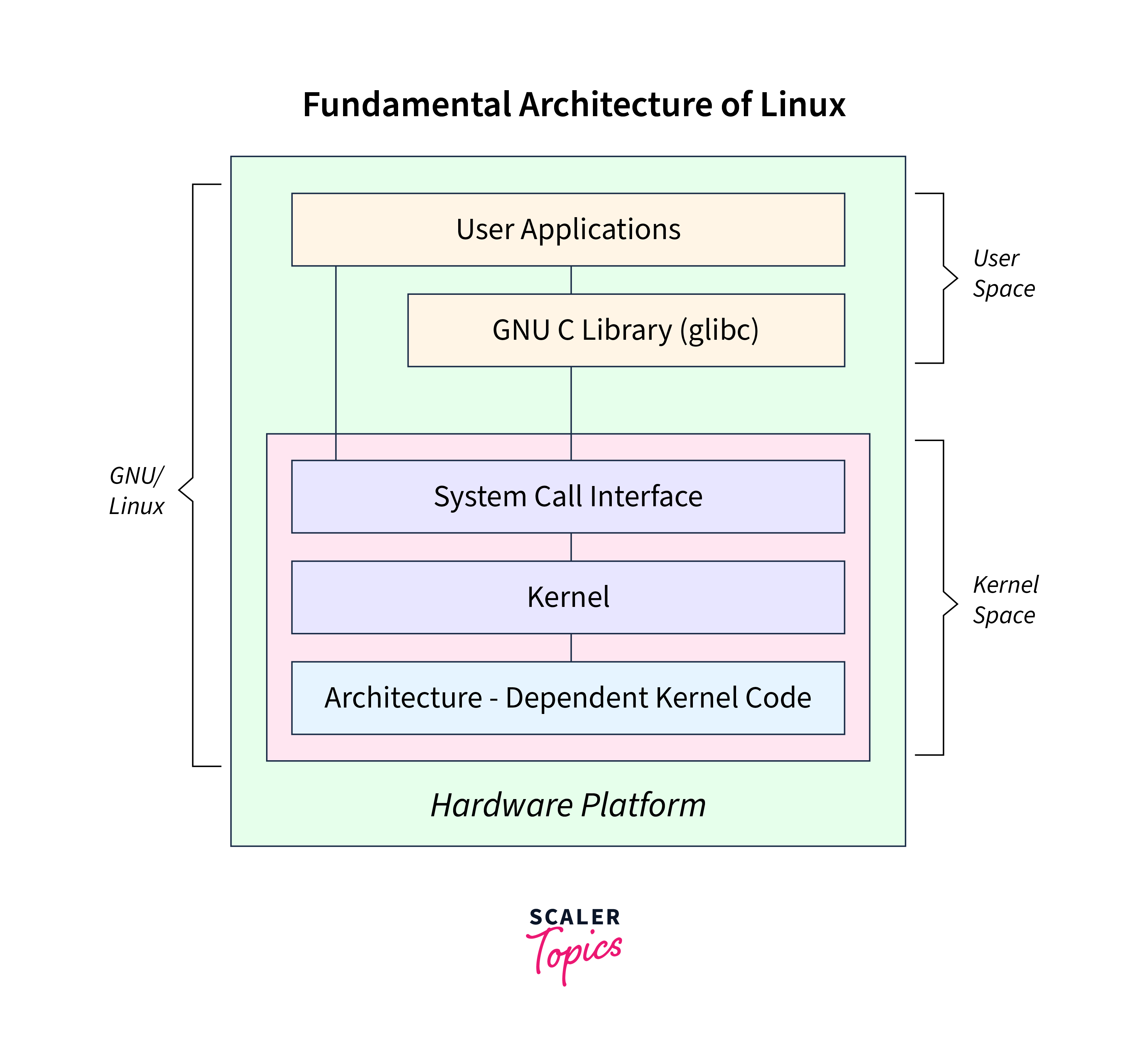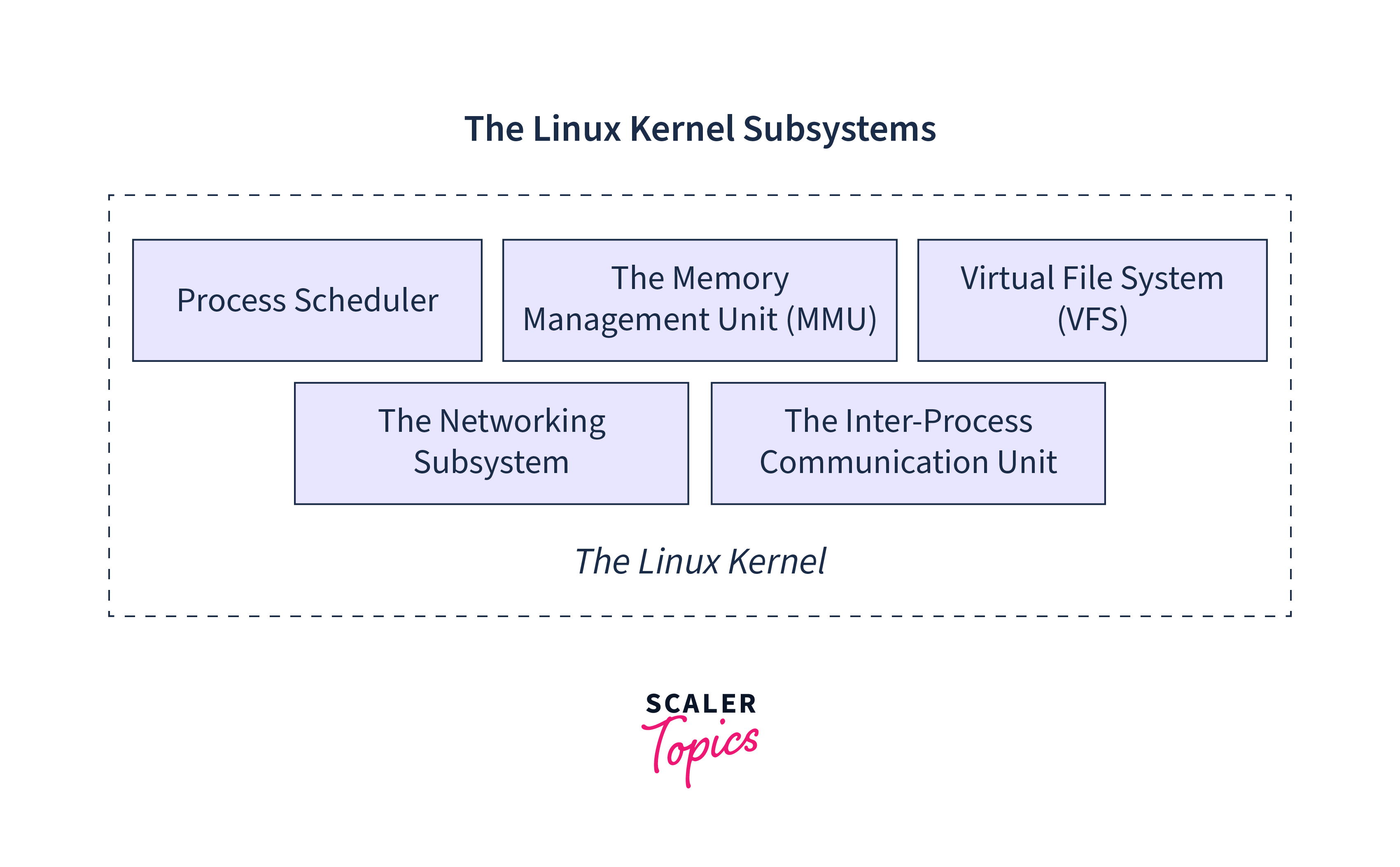Kernel Architecture of Linux
Overview
A kernel is the central component of a Linux operating system that manages the computer and its hardware. It is primarily responsible for memory and CPU time management. As the central component, it is in charge of managing system resources like memory, processors, devices, and input/output processes. Essentially, the Linux kernel serves as an intermediary software layer situated between the hardware and user applications, facilitating seamless communication and effective resource allocation.
What is Linux Kernel?
The Linux kernel is the central component of a Linux operating system, operating as the core interface between a computer's hardware and its processes. It forms the fundamental basis of the entire Linux operating system, with all applications and servers interacting with it. Every Linux distribution builds on the Linux kernel, utilizing its characteristics to provide multiple software capabilities. The kernel in Linux effectively manages system resources, providing enough memory allocation for applications, optimizing processor utilization, and preventing system deadlocks resulting from conflicting demands of different applications.
Fundamental Architecture of Linux The fundamental architecture of Linux is divided into main two parts:
- User Space
- Kernel Space

- 1. User Space:
The User Space is the domain where user applications and processes operate. It is the area where most user-level programs, such as software applications and utilities, execute. User Space does not have direct access to memory or hardware. It connects to the hardware via kernel space. User-space processes or programs can only access some parts of memory via system calls. Crashes in user mode are recoverable due to complete protection. The GNU C library in the user space provides the mechanism for switching user space applications to the kernel space. - 2. Kernel Space:
The Kernel Space, also referred to as the System Space, is a privileged domain dedicated to the execution of kernel programs. It includes all the memory and facilitates interaction with hardware components such as RAM and hard disks. Within the Kernel Space, different blocks and modules handle various operations essential to the operating system, including file management, memory management, and process management. The Kernel Space includes components such as the system call interface, the kernel itself (the core component of Linux), and device modules.
Architecture of Kernel
The architecture of a kernel follows a modular approach. It consists of several components that work together to manage system resources and facilitate communication between different parts of the operating system. The following are the core Subsystems of the Linux Kernel:
- The Process Scheduler
- The Memory Management Unit (MMU)
- The Virtual File System (VFS)
- The Networking Unit
- Inter-Process Communication Unit

The Process Scheduler
This is the primary subsystem of the kernel as it is responsible for distributing the CPU time and resources among all the processes or applications in a fairway. Its purpose is to ensure that no process runs out of CPU resources, allowing multiple applications to run simultaneously without affecting the performance of one. The process scheduler provides fairness, efficiency, and responsiveness by utilizing various scheduling algorithms such as round-robin, priority-based, or multi-level feedback queues.
The Memory Management Unit (MMU)
This kernel subsystem is responsible for managing and organizing the system's memory resources. It is responsible for ensuring that memory is allocated and distributed appropriately among multiple processes and applications, preventing issues such as crashes or kernel mode errors caused by insufficient memory. By efficiently managing memory, this subsystem ensures that processes and applications have access to the necessary memory resources and prevents memory-related errors.
The Virtual File System (VFS)
The Virtual File System (VFS) subsystem inside the kernel is responsible for providing an equal interface to all available filesystems on the computer and allowing them to access the stored data on those file systems. It abstracts the details of different file systems, such as ext4, NTFS, or FAT, and provides a consistent file I/O interface to user programs. Regardless of the underlying file system, the VFS layer enables programs to do file-related actions such as opening, reading, writing, and closing files.
The Networking Unit
The Networking Unit subsystem in the Linux kernel is an essential component located within the kernel space. It plays a crucial role in facilitating communication between hosts, even if they are not directly connected. In X-Windows, the network subsystem is used for client-server communication, allowing applications to connect over a network. The Linux Kernel's networking stack handles incoming packets, processing them from Layer 2 (data link layer) up to the network layer.
Inter-Process Communication Unit
The inter-process communication (IPC) unit facilitates communication and data sharing between distinct operating system processes or threads. Linux supports a number of Inter-Process Communication (IPC) mechanisms. Signals and pipes are two of them, but Linux also supports the System V IPC mechanisms, which are named after the Unix TM release in which they were initially introduced.
Features of Linux Kernel
If the portability and efficiency of the Linux kernel weren't enough, it also has a few more features.
- Linux, as an open-source production operating system, serves as an ideal platform for testing and advancing new protocols. It supports a broad number of networking protocols, including the commonly used TCP/IP suite. Furthermore, Linux has extensions particularly designed for high-speed networking, which surpasses the capabilities of typical 1 Gigabit Ethernet (GbE) and 10 GbE protocols. Furthermore, Linux embraces protocols such as the Stream Control Transmission Protocol (SCTP), which provides additional functionality beyond TCP and might potentially serve as a substitute transport-level protocol.
- Linux is well-known for its dynamic kernel, which allows for both the addition and removal of software components while the system is running. These components, known as dynamically loadable kernel modules, can be inserted when necessary during system boot (when a specific device is found requiring the module) or at any time by the user.
- Linux's most recent advancement is its usage as an operating system for other operating systems (known as a hypervisor). This is made feasible through a kernel modification known as Kernel-based Virtual Machine (KVM). The KVM modification adds a new user-space interface, allowing alternative operating systems to operate on top of a KVM-enabled kernel. This advancement enables not only the virtualization of additional instances of Linux but also the virtualization of Windows.
Conclusion
- A kernel is the central component of a Linux operating system that manages the computer and its hardware.
- The Linux kernel is the central component of a Linux operating system, operating as the core interface between a computer’s hardware and its processes.
- Linux's fundamental architecture is divided into two parts: user space and kernel space.
- The process scheduler subsystem of the kernel is responsible for distributing the CPU time and resources among all the processes or applications in a fairway.
- The MMU kernel subsystem is responsible for managing and organizing the system’s memory resources.
- The Virtual File System (VFS) subsystem inside the kernel is responsible for providing an equal interface to all available filesystems on the computer and allowing them to access the stored data on those file systems.
- Linux is well-known for its dynamic kernel, which allows for both the addition and removal of software components while the system is running.
